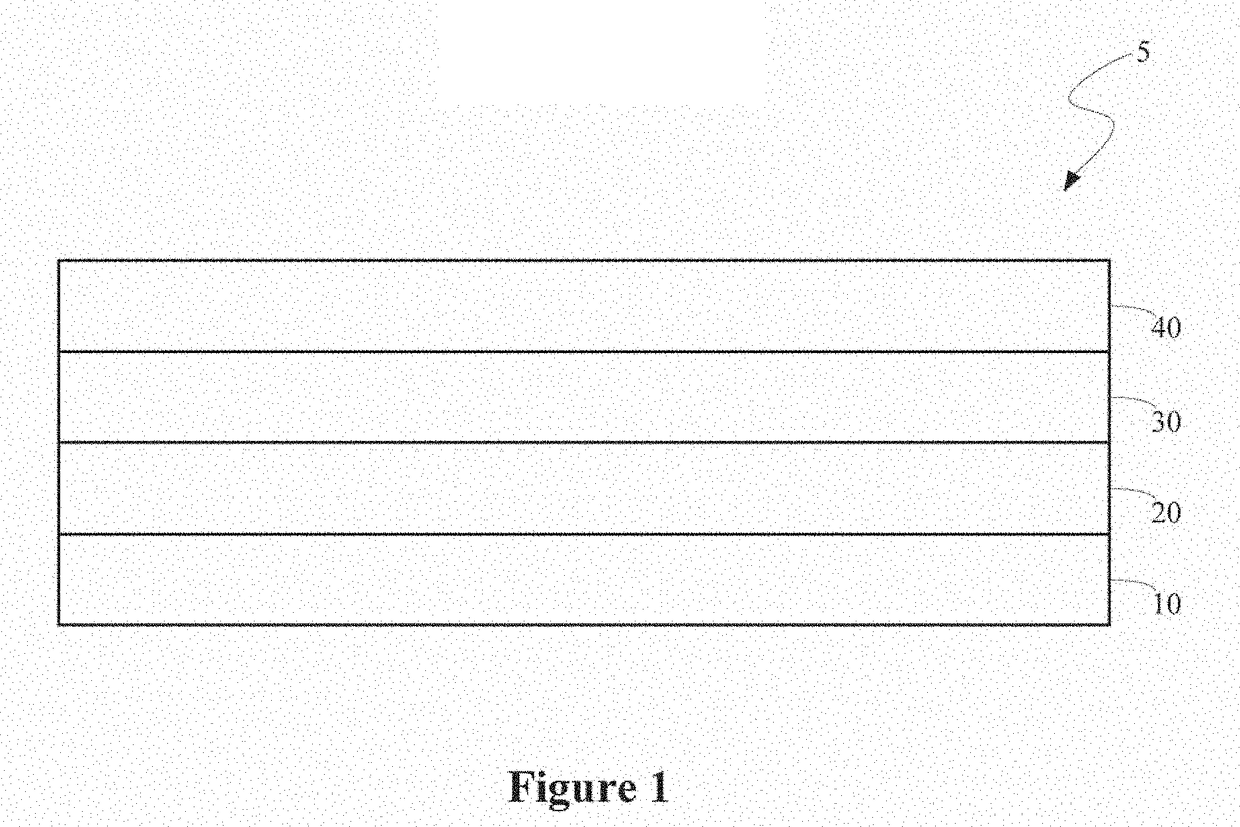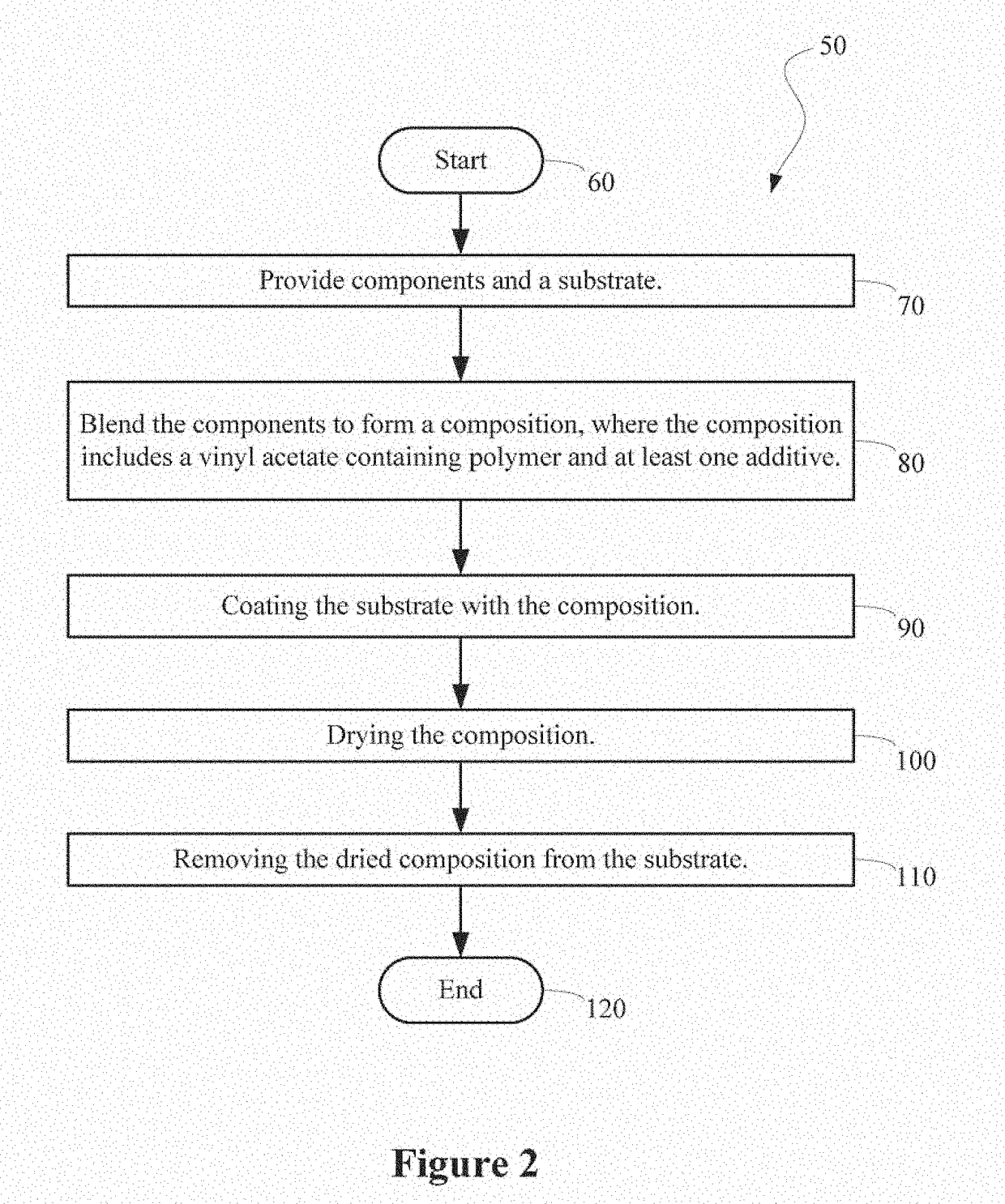Composition, film and related methods
a technology of film and adhesives, applied in the direction of pretreatment surfaces, synthetic resin layered products, printing, etc., can solve the problems of halogen-containing materials and pvc generally recognized as producing undesirable by-products, and achieve the effects of easy coloration with pigments and dyes, good printing, and easy modification of opacity
- Summary
- Abstract
- Description
- Claims
- Application Information
AI Technical Summary
Benefits of technology
Problems solved by technology
Method used
Image
Examples
example 1
[0099]In separate containers, the following mixtures were prepared:[0100]A. 32.5 parts of KRONOS 4311 (25 parts dry)[0101]B. 2.5 part of water and 0.26 part of ZONYL FS-300[0102]C. 2.5 parts TAMOL 731A (0.6 part dry)[0103]D. 181 parts of AIRFLEX 323 (100 parts dry)[0104]E. 0.2 part of DREWPLUS L-198
[0105]Components A, B, and C were mixed well and added to D, and then, E was added. The blend was then coated over a 1.4 mil PET film. The resulting VAE film was then peeled off from the PET film.
example 2
[0106]In separate containers, the following mixtures were prepared:[0107]A. 30.8 parts of AIRFLEX 465 (20 parts dry) and 145 parts of AIRFLEX 323 (80 parts dry)[0108]B. 2.5 part of water and 0.26 part of ZONYL FS-300[0109]C. 19.5 parts of KRONOS 4311[0110]D. 0.2 part of DREWPLUS L-198
[0111]Component B was mixed well and added to C, and then, the mixture was added to A under agitation, and next D was added. The resulting solids were 58%. The blend was then coated over a 2 mil PET film. The resulting VAE film was then peeled off from the PET film.
[0112]The above formulation of Example 2 was then prepared in a larger amount. The blend was coated on 2 mil PET at a 2.7 mil thickness. The coated film was then printed using a MIMAKI JV3 solvent ink jet printer available from Mimaki Engineering Co., Ltd. of Nagano, Japan. No color-to-color bleed was observed by visual inspection, and the quality of print was good.
example 3
[0113]The composition of the formulation was the same as in Example 2. The formulation was scaled-up to a large volume and then coated in a pilot coater over 1.4 mil PET. The coated film was then laminated to a PSA with release liner. The coated film was about 1.9 mil. In other embodiments, the formulation is coated in the pilot coater over 0.92 mil PET or 2.0 mils PET. After peeling off the PET film, the gloss level was 82 and 96 at a 60 and 85 degree angle, respectively.
[0114]The same formulation was then coated using a dual die method over a release liner with VAE emulsion on the top and PSA emulsion (AROSET 3300 from Ashland Inc.) in between the VAE emulsion and the release liner. In addition to coating using a dual die method, in other embodiments, the formulation is coated using slide coating, reverse scroll, slot die, and / or curtain coating methods. In wet state, it formed a good two-layer type of coating.
PUM
| Property | Measurement | Unit |
|---|---|---|
| elongation | aaaaa | aaaaa |
| tensile elongation at break | aaaaa | aaaaa |
| thickness | aaaaa | aaaaa |
Abstract
Description
Claims
Application Information
 Login to View More
Login to View More - R&D
- Intellectual Property
- Life Sciences
- Materials
- Tech Scout
- Unparalleled Data Quality
- Higher Quality Content
- 60% Fewer Hallucinations
Browse by: Latest US Patents, China's latest patents, Technical Efficacy Thesaurus, Application Domain, Technology Topic, Popular Technical Reports.
© 2025 PatSnap. All rights reserved.Legal|Privacy policy|Modern Slavery Act Transparency Statement|Sitemap|About US| Contact US: help@patsnap.com


